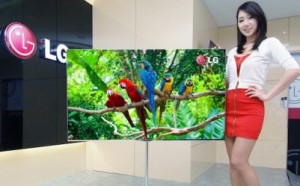LGD Postpones OLED-TV Panel Production to 2013

LG Display’s 55-inch OLED-TV panels will not see volume production until 2013, reported Digitimes’ Julian Ho and Alex Wolfgram this morning, citing an unidentified “report from Japan.” Although this is not the strongest imaginable sourcing for a story, it is highly plausible. Let’s see why.
- It’s September. If LGD hasn’t gotten beyond pilot production by now, it’s hard to see how they can ramp up volume production at a new plant until well into 2013.
- I told you so. It may not be gracious to say it, but I’ve been observing in presentations for at least a year that LGD may have committed itself to metal-oxide backplanes too early, and there have been a string of reports that LGD itself has not been pleased with its oxide-TFT performance. Even statements from LGD executives that the problems were being resolved acknowledged that problems existed. I have been saying that LGD’s ability to adhere to its own introduction timeline would be a key indicator of whether they were having serious trouble. They have now missed two of their own goals – the London Olympics and Q3’12 – and we can fairly conclude that, yes, there is trouble in River City.
Of course, there is room for problems elsewhere. LGD’s (formerly Kodak’s) color-by-white OLED approach has not been proved in volume production. It should be easier to implement than Samsung’s RGB process, but Samsung has now cranked out millions of small and medium RGB OLEDs. It should be noted that Samsung struggled for years with lifetime and yield issues before getting the volume manufacturing right. What are the possible problem areas in LGD’s front-plane technology?
Unlike the Samsung RGB approach, LGD does not have to pattern its white OLED layers, which are continuous and deposited from a linear source. Could there be uniformity issues with this process?
The white emissive layer is actually made up of a mixture of red and green (or maybe yellow), and blue emissive materials, which are essentially the same materials used in Samsung’s RGB architecture. It is generally believed that the blue phosphor, which has the shortest lifetime of the group, will last longer in the mixture than it does in the RGB structure. What if that is not turning out to be the case?
This is speculation, of course. The best bet for LGD’s delay is still the oxide backplane. Oxide remains the most promising next-generation semiconductor material for thin-film transistors (TFTs), and Sharp has apparently gotten it to work for LCDs in volume production. But oxide researchers overwhelmingly say there are a few remaining stability issues, at least when oxide TFTs are used with OLEDs that will take another year or so to resolve.
It is not unusual in the world of high-technology products for developers to jump out of the airplane and attempt to sew their parachute on the way down. For this jump, it looks like LGD ran out of thread.





